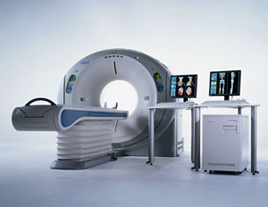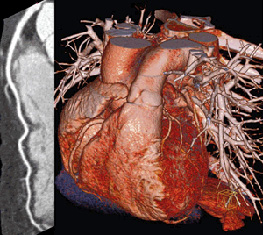 CT/Coronary CTA
CT/Coronary CTA
What is Computed Tomography?
CT (computed tomography), also called a CAT scan, uses x-ray and computer equipment to produce cross-sectional images from of body issues and organs. CT imaging is useful because it can show several types of tissue, such as lung, bone, soft tissue and blood vessels.
What are some common uses of CT?
- Studying the chest and abdomen.
- Diagnosing cancer. CT examinations are often used to: •Plan and properly administer radiation treatments for tumors.
- Guide biopsies and other minimally invasive procedures.
- Plan surgery.
- Determine surgical resectability.
- Diagnosing and treating spinal problems and injuries to the hands, feet and other skeletal structures.
- Measuring bone mineral density for the detection of osteoporosis.
- Identifying injuries to the liver, spleen, kidneys, or other internal organs.
- Detecting, diagnosing and treating vascular diseases that can lead to stroke, kidney failure, or even death.
How should I prepare for a CAT scan?
- On the day of your exam, wear comfortable, loose-fitting clothing.
- Avoid clothing with zippers and snaps as metal objects can affect the image.
- Depending on the part of the body that is being scanned, you may also be asked to remove hair pins, jewelry, eyeglasses, hearing aids and any dentures.
- You may be asked not to eat or drink anything for one or more hours before the exam.
- Women should inform their doctor or x-ray tech if there is any possibility that they are pregnant.
What should I expect during this exam?
A CT examination usually takes five minutes to half an hour.
- The technologist positions you on the CT table and pillows are used to help keep you still and in the proper position during the scan. The table will move slowly into the CT scanner opening. Depending on the area of the body being examined, the increments of movement may be very small and almost undetectable, or large enough to feel the motion.
- To enhance the visibility of certain tissues or blood vessels, use of different contrast materials may be required. Depending on the type of examination, contrast material may be injected through an IV, swallowed or administered by enema. Before administering the contrast material, you should inform the radiologist or technologist of the following:
- Any allergies, especially to medications or iodine,
- Whether you have a history of diabetes, asthma, kidney problems, heart or thyroid conditions. These conditions may indicate a higher risk of reaction to the contrast material or potential problems eliminating the material from the patient's system after the exam.
- You will be alone in the room during your scan however your technologist can see, hear and speak with you at all times. If necessary, many centers allow a friend or family member to stay in the room with you during the exam. To prevent radiation exposure, the friend or family member will be required to wear a lead apron.
- To determine if more images are needed, you may be asked to wait until the images are reviewed.
What will I experience during the procedure?
CT scanning is painless. Depending on the type of scan you are having, your preparation may differ. To enhance the visibility of body tissue or blood vessels, use of different contrast materials may be administered by:
- Mouth: You may be asked to swallow water or contrast material, a liquid that allows the radiologist to better see the stomach, small bowel and colon. Some patients find the taste of the contrast material slightly unpleasant, but tolerable.
- Enema: For a study of the colon, your exam may require the administration of the contrast material by enema. You will experience a sense of abdominal fullness and may feel an increasing need to expel the liquid. The discomfort is generally mild.
- IV injection: To accentuate the appearance between normal and abnormal tissue in organs like the liver and spleen and to better define the blood vessels and kidneys, a contrast material is commonly injected into a vein. You might feel:
- Flushed or have a metallic taste in your mouth. These are common reactions which disappear in a minute or two.
- A mild itching sensation. If the itching persists or is accompanied by hives, it can be easily treated with medication.
- In very rare cases, you may experience shortness of breath or swelling in the throat or other parts of the body. These can be indications of a more serious reaction to the contrast material. Your technologist should be notified immediately.
What is Coronary CT Angiography used to diagnose?
Coronary Artery Disease is the single leading cause of death in the United States. Of the 1.2 million Americans who have heart attacks every year, approximately 150,000 of them die without showing any symptoms. With the advancement of CT scanners, this technology is being used to identify and diagnose diseases and conditions affecting the flow of blood in veins and arteries throughout the body in patients with and without symptoms. Typical vessels examined include those serving the brain and those bringing blood to the heart, lungs, kidneys, arms, and legs. Compared to traditional catheter angiography, CTA is much less invasive, more patient-friendly and in many cases presents a cost effective alternative that delivers better detail and more information.
What is Coronary CT Angiography?
Coronary CT Angiography is a minimally invasive diagnostic imaging procedure that uses a state- of –the-art CT scanner to provide high-speed x-ray images of literally hundreds of cross-sectional views of your body to yield detailed images of the blood flowing through the veins and arteries. When the CT scanner completes its programmed scan of the particular area that needs to be studied, a powerful computer takes the digitally stored data from the images and reconstructs them in 3D. This allows the radiologist to view your anatomy from any angle without having the image blocked by intervening structures. The images presented provide extremely accurate information for the radiologist to make a diagnosis so your cardiologist and or physician can treat you.
Is Coronary CT Angiography right for me?
Your physician or cardiologist determines if coronary CTA is appropriate for your condition. Generally speaking, if you have symptoms such as shortness of breath or chest pain indicating the possibility of coronary artery disease, you would be considered a candidate for the exam. Additionally, there are many people who do not outwardly show any symptoms however, they do have conditions which are associated with risk factors for the disease. If you have high blood pressure, diabetes, high cholesterol, are overweight, smoke or lead a sedentary lifestyle, any one of these factors or a combination of them would make you a candidate for the exam pending your physician’s approval.
Is Coronary CT Angiography Safe?
Not only is this technique invaluable for delineation of the body’s blood vessels, it is also relatively safe, convenient and much less invasive than traditional angiography where a sizable catheter is generally threaded through a vein or artery. In many cases, CT angiography may eliminate the need for surgery. The major risk associated with CT angiography is an allergic reaction to contrast materials used to improve the visualization of the veins and arteries.
How should I prepare for this procedure?
Wear comfortable, loose-fitting clothing. You may be given a gown to wear during the procedure. Metal objects such as jewelry, eyeglasses, dentures and hairpins should not be worn since they could negatively affect the CT images. You may also be asked to remove hearing aids and dental work, such as bridges and dentures. You may be asked not to eat or drink anything for several hours before the exam, especially if contrast material will be used. You should inform your technologist or physician of any medications you are taking and whether or not you have any allergies, especially to contrast materials. You should also tell your technologist or physician of any recent illnesses, if you are pregnant or have other medical conditions such as a history of heart disease, asthma, diabetes, and kidney disease or thyroid problems. Women who are breastfeeding may find it advisable to pump breast milk ahead of time so that it can be used until all the contrast material has been removed from your body.
What should I expect during this exam?
The procedure generally takes about an hour. Depending on the area to be examined, you will be positioned on the CT table on your back, side or stomach and straps and pillows may be used to help maintain the correct position and hold you still during the exam. A nurse or technologist will insert an intravenous line (IV) into your hand or arm and a small amount of contrast material may be injected to see how long it takes to reach the area to be examined. After this, the CT table with you on it will be moved quickly through the scanner to determine the correct starting position for the scan and a test image will be taken. The actual exam will begin after this and you will move slowly through the scanner. At all times a technologist will be able to see, hear and speak with you. While the images are being recorded, you will hear an array of noises and an automatic injector connected to the IV will inject contrast material at a controlled rate. You may be asked to hold your breath during the scanning. When the exam is complete your IV will be removed.
While the scanning causes no pain, there may be discomfort from having to remain still for several minutes. For patients who find it difficult to remain still or who are claustrophobic or in chronic pain, a mild sedative prescribed by their physician may provide relief. If intravenous contrast material is used, you may experience a warm, flushed sensation and a metallic taste in your mouth that lasts for a few minutes. Minor reactions include itching and hives which can be relieved with medication. Light-headedness or difficulty breathing indicate a more severe allergic reaction and you should tell the technologist or nurse about it. After the exam, and depending upon whether or not contrast material was used, you can return to your normal activities.






